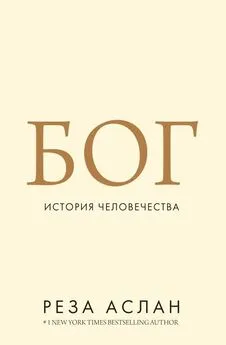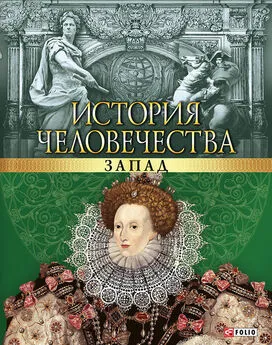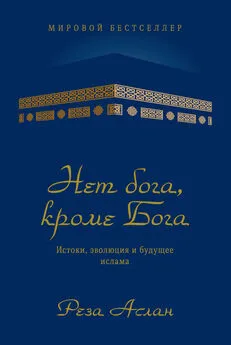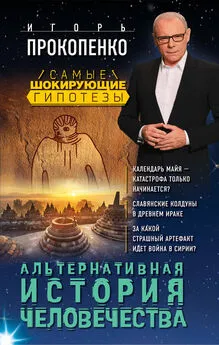Реза Аслан - Бог. История человечества
- Название:Бог. История человечества
- Автор:
- Жанр:
- Издательство:Литагент Аттикус
- Год:2017
- ISBN:978-5-389-15978-5
- Рейтинг:
- Избранное:Добавить в избранное
-
Отзывы:
-
Ваша оценка:
Реза Аслан - Бог. История человечества краткое содержание
«Мы моделируем религии и культуры, сообщества и правительства в соответствии с нашими человеческими требованиями, при этом постоянно убеждая себя, что эти требования – божественные. Это лучше всего объясняет, почему на протяжении всей человеческой истории религия порождала и бесконечное добро, и невыразимое зло; почему одна и та же вера в одного и того же Бога рождает любовь и сострадание в одном верующем, в то время как в другом – ненависть и жестокость… Эта книга – не только история о том, как мы очеловечили Бога. Это также призыв перестать навязывать Богу наши человеческие страсти. Независимо от того, верите вы в одного Бога, в нескольких богов или не верите вовсе, важно помнить, что это мы создали Бога по своему образу и подобию, а не наоборот. И эта истина открывает нам путь к более зрелой, более мирной, первичной форме духовности». (Реза Аслан)
Бог. История человечества - читать онлайн бесплатно ознакомительный отрывок
Интервал:
Закладка:
––. Zealot: The Life and Times of Jesus of Nazareth. N. Y.: Random House, 2013. [Рус. изд.: Аслан Р. ZEALOT. Иисус. Биография фанатика. М.: АСТ, 2014.]
Assman Jan . The Mind of Egypt. N. Y.: Metropolitan, 1996.
––. The Search for God in Ancient Egypt. David Lorton (transl.). Ithaca and London: Cornell University Press, 2001.
––. Of Gods and Gods: Egypt, Israel, and the Rise of Monotheism. Madison: University of Wisconsin Press, 2008.
––. From Akhenaten to Moses: Ancient Egypt and Religious Change. Cairo: American University in Cairo, 2014.
Astour Michael C. Yahweh in Egyptian Topographic Lists. Festschrift Elmar Edel in Ägypten und Altes Testament. Manfred Görg (ed.). Bamberg, Germany: Görg, 1979. P. 17–19.
Atlas S. The Philosophy of Maimonides and Its Systematic Place in the History of Philosophy // Philosophy 11/41 (1936). P. 60–75.
Atran Scott. In Gods We Trust: The Evolutionary Landscape of Religion. N. Y.: Oxford University Press, 2002.
Atwell James. An Egyptian Source for Genesis // Journal of Theological Studies 51/2 (2000). P. 441–477.
Aubert Maxime et al . Pleistocene Cave Art from Sulawesi, Indonesia // Nature 514 (2014). P. 223–227.
Bahn Paul. The Cambridge Illustrated History of Prehistoric Art. Cambridge: Cambridge University Press, 1998.
Bahn Paul, Natalie Franklin, Matthias Stecker (eds.). Rock Art Studies: News of the World IV. Oxford: Oxbow Books, 2012.
Baines John . Kingship, Definition of Culture, and Legitimation. Ancient Egyptian Kingship. David O’Connor, David P. Silverman (eds.). Leiden: Brill, 1995. P. 3–48.
Bandstra Barry. Reading the Old Testament: Introduction to the Hebrew Bible. 4th ed. Belmont, Calif.: Wadsworth, 2009.
Banning E. B. The Neolithic Period: Triumphs of Architecture, Agriculture, and Art // Near Eastern Archaeology 61/4 (1998). P. 188–237.
Barkley Russell A. Executive Functions: What They Are, How They Work, and Why They Evolved. N. Y.: Guilford Press, 2012.
Barks Coleman. The Essential Rumi. N. Y.: HarperOne, 2004.
Barrett Justin L. Cognitive Constraints on Hindu Concepts of the Divine // Journal for the Scientific Study of Religion 37 (1998). P. 608–619.
––. Theological Correctness: Cognitive Constraint and the Study of Religion // Method and Theory in the Study of Religion 11 (1998). P. 325–339.
––. Exploring the Natural Foundations of Religion // Trends in Cognitive Sciences 4/1 (2000). P. 29–34.
––. Why Would Anyone Believe in God? Lanham, Md.: Altamira Press, 2004.
––. Cognitive Science, Religion and Theology. The Believing Primate: Scientific, Philosophical, and Theological Reflections on the Origin of Religion. J. Schloss, M. Murray (eds.). Oxford: Oxford University Press, 2009. P. 76–99.
––. Born Believers: The Science of Children’s Religious Belief. N. Y.: Atria Books, 2012.
Barton C. Michael, G. A. Clark, Allison E. Cohen. Art as Information: Explaining Upper Palaeolithic Art in Western Europe // World Archaeology 26/2 (1994). P. 185–207.
Barua Ankur. God’s Body at Work: Rāmānuja and Panentheism // International Journal of Hindu Studies 14/1 (2010). P. 1–30.
Bar-Yosef Ofer. The PPNA in the Levant – An Overview // Paléorient 15/1 (1989). P. 57–63.
Bausani Alessandro. Theism and Pantheism in Rumi // Iranian Studies 1/1 (1968). P. 8–24.
Begouën Robert, Jean Clottes . Les Trois-Frères after Breuil // Antiquity 61 (1987). P. 180–187.
Begouën Robert, Carole Fritz, and Gilles Tosello . Parietal Art and Archaeological Context: Activities of the Magdalenians in the Cave of Tuc d’Audoubert, France. A Companion to Rock Art. Jo McDonald, Peter Veth (eds.). London: Chichester, U. K.: Wiley-Blackwell, 2012. P. 364–380.
Berghaus Gunter. New Perspectives on Prehistoric Art. Westport, Conn.: Praeger, 2004.
Bering Jesse M. Intuitive Conceptions of Dead Agents’ Minds: The Natural Foundations of Afterlife Beliefs as Phenomenological Boundary // Journal of Cognition and Culture 2/4 (2002). P. 263–308.
––. The Cognitive Psychology of Belief in the Supernatural: Belief in a Deity or an Afterlife Could Be an Evolutionarily Advantageous By-product of People’s Ability to Reason About the Minds of Others // American Scientist 94/2 (2006). P. 142–149.
––. The Folk Psychology of Souls // Behavioral and Brain Sciences 29/5 (2006). P. 462–498.
Berlejung Angelika . Washing the Mouth: The Consecration of Divine Images in Mesopotamia. The Image and the Book: Iconic Cults, Aniconism, and the Rise of the Book Religion in Israel and the Ancient Near East. K. van der Toorn (ed.). Leuven: Peeters, 1997. P. 45–72.
Binford Lewis R . Post-Pleistocene Adaptations. New Perspectives in Archaeology. L. R. Binford, S. R. Binford (eds.). Chicago: Aldine, 1968. P. 313–342.
Binns L. Elliott. Midianite Elements in Hebrew Religion // Journal of Theological Studies 31/124 (1930). P. 337–354.
Bird-David Nurit . “Animism” Revisited: Personhood, Environment, and Relational Epistemology // Current Anthropology 40/S1 (1999). P. S67–S91.
Black Whitney Davis et al . Art for Art’s Sake in the Paleolithic [and Comments and Reply] // Current Anthropology 28/1 (1987). P. 63–89.
Blanc Alberto C. Some Evidence for the Ideologies of Early Man. Social Life of Early Man. Sherwood Washburn (ed.). London: Routledge, 2004. P. 119–136.
Bloch Maurice . In and Out of Each Other’s Bodies: Theory of Mind, Evolution, Truth, and the Nature of the Social. N. Y.: Routledge, 2016.
Bloom Paul. Descartes’ Baby: How the Science of Child Development Explains What Makes Us Human. N. Y.: Basic Books, 2004.
––. Religious Belief as an Evolutionary Accident. The Believing Primate. Jeffrey Schloss, Michael J. Murray (eds.). Oxford: Oxford University Press, 2009. P. 118–127.
––. Religion, Morality, Evolution // Annual Review of Psychology 63 (2012). P. 179–199.
Boak Arthur Edward Romilly. The Theoretical Basis of the Deification of Rulers in Antiquity // The Classical Journal 11/5 (1916). P. 293–297.
Bosch-Gimpera P. Review Four Hundred Centuries of Cave Art by Abbé H. Breuil // Boletín Bibliográfico de Antropología Americana 15/2 16/2 (1952–1953). P. 80–82.
Bottéro Jean . Religion in Ancient Mesopotamia. Teresa Lavender Fagan (transl.). Chicago: University of Chicago Press, 2004.
Boutwood Arthur. A Scientific Monism // Proceedings of the Aristotelian Society, New Series 1 (1900–1901). P. 140–166.
Boyce Mary . History of Zoroastrianism. 3 vols. Leiden: Brill, 1975–1991.
Boyd Robert et al. The Evolution of Altruistic Punishment // Proceedings of the National Academy of Sciences 100/3 (2003): 3531–3535.
Boyer Pascal . The Naturalness of Religious Ideas: A Cognitive Theory of Religion. Berkeley and Los Angeles: University of California Press, 1994.
––. Religion Explained: The Evolutionary Origins of Religious Thought. N. Y.: Basic Books, 2001. [Рус. изд.: Буайе П. Объясняя религию. М.: Альпина нон-фикшн, 2016.]
Braidwood Robert J. The Agricultural Revolution // Scientific American 203 (1960). P. 130–141.
––. Prehistoric Men. 6th ed. Chicago: Chicago Natural History Museum, 1963.
Brandon S. G. F. The Ritual Perpetuation of the Past // Numen 6/2 (1959). P. 112–129.
Breasted James. Ancient Records of Egypt. Vol. 2. Chicago: University of Chicago Press, 1906.
Breuil Abbé Henri. Four Hundred Centuries of Cave Art. Mary E. Boyle (transl.). N. Y.: Hacker Art Books, 1979 [1952].
––. White Lady of Brandberg: Rock Paintings of South Africa. Vol. 1. London: Faber and Faber, 1955.
Breuil Abbé Henri, Raymond Lantier. The Men of the Old Stone Age. N. Y.: St. Martin’s Press, 1965.
Brisch Nicole. The Priestess and the King: The Divine Kingship of Šū-Sîn of Ur // Journal of the American Oriental Society 126/2 (2006). P. 161–76.
Broadie Sarah. Theological Sidelights from Plato’s “Timaeus” // Proceedings of the Aristotelian Society, Supplementary Volumes 82 (2008). P. 1–17.
Brown Francis, S. R. Driver, Charles Briggs. A Hebrew and English Lexicon of the Old Testament. Oxford: Oxford University Press, 1951.
Burckhardt Titus. Introduction to Sufism. London: Thorsons, 1995.
Burger Peter. The Sacred Canopy: Elements of a Sociological Theory of Religion. N. Y.: Doubleday, 1967.
Burkert Walter. Greek Religion. John Raffan (transl.). Cambridge, Mass.: Harvard University Press, 1985.
––. Creation of the Sacred: Tracks of Biology in Early Religions. Cambridge, Mass.: Harvard University Press, 1996.
Burkit Miles C. Review of La Signification de l’Art Rupestre Paléolithique // Man 63 (1963). P. 14.
Call Josep, Michael Tomasello . Does the Chimpanzee Have a Theory of Mind? 30 Years Later // Trends in Cognitive Sciences 12/5 (2008). P. 187–92.
Carneiro Robert L . Review of The Birth of the Gods and the Origins of Agriculture by Jacques Cauvin // American Antiquity 67/3 (2002). P. 575–576.
Cartailhac Émile. Les mains inscrites de rouge ou de noir de Gargas // L’anthropologie 17 (1906). P. 624–625.
Carter Tim. Marcion’s Christology and Its Possible Influence on Codex Bezae // The Journal of Theological Studies 61/2 (2010). P. 550–582.
Cauvin Jacques. The Birth of the Gods and the Origins of Agriculture. Trevor Watkins (transl.). New Studies in Archaeology; Cambridge: Cambridge University Press, 2007.
Cauvin Jacques, Ian Hodder, Gary O. Rollefson, Ofer Bar-Yosef, Trevor Watkins . Review of The Birth of the Gods and the Origins of Agriculture by Jacques Cauvin // Cambridge Archaeological Journal 11/01 (2001). P. 105–121.
Chalupa Aleš. How Did Roman Emperors Become Gods? Various Concepts of Imperial Apotheosis // Anodos – Studies of the Ancient World 6–7 (2006–2007). P. 201–207.
Childe Vere Gordon . The Urban Revolution // Town Planning Review 21/1 (1950). P. 3–17.
––. Man Makes Himself: History of the Rise of Civilization. 3d ed. London: Watts and Company, 1936.
Chipp Herschel B. Review of Palaeolithic Art // Art Journal 22/1 (1962). P. 54–56.
Chittenden Jacqueline . The Master of Animals // Hesperia: The Journal of the American School of Classical Studies at Athens 16/1 (1947). P. 89–114.
Chittick William C. The Sufi Path of Knowledge: Ibn al-Arabi’s Metaphysics of Imagination. Albany: SUNY Press, 1989.
Cicero . The Nature of the Gods. P. G. Walsh (transl.). Oxford: Oxford University Press, 2008.
Clark Geoffrey A . Grave Markers: Middle and Early Upper Paleolithic Burials and the Use of Chronotypology in Contemporary Paleolithic Research // Current Anthropology 42/4 (2001). P. 449–479.
Clottes Jean, David Lewis-Williams . The Shamans of Prehistory: Trance Magic and the Painted Caves. N. Y.: Abrams, 1998.
Coats George W . Moses in Midian // Journal of Biblical Literature 92/1 (1973). P. 3–10.
Cohen Martin. The Role of the Shilonite Priesthood in the United Monarchy of Ancient Israel // Hebrew Union College Annual 36 (1965). P. 59–98.
Читать дальшеИнтервал:
Закладка:









